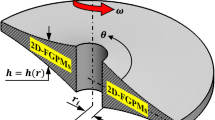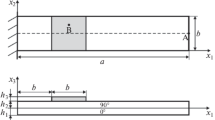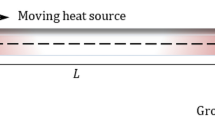Summary
This paper deals with a smart composite disk for control of a thermoelastic deformation resulting from an unknown thermal load. The disk consists of a structural layer onto which piezoelectric sensor and actuator layers are bonded. First, an unknown heating temperature distribution is inferred from a sensor output. The thermoelastic displacement on the bottom free surface is then controlled by applying electric potentials to electrodes on the actuator layers. For a composite disk with one actuator layer, applied electric potentials are determined by solving a direct optimization problem with and without stress constraints, respectively. The introduction of the stress constraints leads to a deterioration in the effectiveness of the displacement control. In order to resolve this issue, an approximate optimum design problem of a composite disk with two actuator layers is solved under stress constraints. As a result, the thermoelastic displacement is satisfactorily controlled to the desired distribution.
Similar content being viewed by others
Explore related subjects
Discover the latest articles and news from researchers in related subjects, suggested using machine learning.References
Rao S. S. and Sunar M. (1994). Piezoelectricity and its use in disturbance sensing and control of flexible structures: a survey. Tran. ASME App. Mech. Rev. 47: 113–123
Sunar M. and Rao S. S. (1999). Recent advances in sensing and control of flexible structures via piezoelectric materials technology. Trans. ASME App. Mech. Rev. 52: 1–16
Irschik H. (2002). A review on static and dynamic shape control of structures by piezoelectric actuation. Engng. Struct. 24: 5–11
Tauchert T. R., Ashida F. and Noda N. (1999). Recent developments in piezothermoelasticity: inverse problems relevant to smart structures. JSME Int. J. Series A 42: 452–458
Tauchert T. R., Ashida F., Noda N., Adali S. and Verijenko V. (2000). Developments in thermopiezoelasticity with relevance to smart composite structures. Comp. Struct. 48: 31–38
Tauchert T. R. and Ashida F. (2003). Control of transient response in intelligent piezothermoelastic structures. J. Thermal Stresses 26: 559–582
Ashida F., Choi J.-S. and Noda N. (1997). Control of elastic displacement in piezoelectric-based intelligent plate subjected to thermal load. Int. J. Engng. Sci. 35: 851–868
Tauchert T. R. and Ashida F. (1999). Application of the potential function method in piezothermoelasticity: solutions for composite circular plates. J. Thermal Stresses 22: 387–419
Ashida F., Tauchert T. R., Sakata S. and Yamashita Y. (2003). Control of transient deformation in a heated intelligent composite disk. Smart Mater. Struct. 12: 825–835
Ashida F., Tauchert T. R., Sakata S. and Yoshida S. (2007). Optimum design of a piezo-composite disk for control of thermoelastic displacement distribution. J. Thermal Stresses 3: 559–586
Ashida F., Tauchert T. R. and Noda N. (1994). Potential function method for piezothermoelastic problems of solids of crystal class 6mm in cylindrical coordinates. J. Thermal Stresses 17: 361–375
Ashida F. and Tauchert T. R. (2002). Control of transient thermoelastic displacement in a composite disk. J. Thermal Stresses 25: 99–121
Ashida F., Noda N. and Okumura I. A. (1993). General solution technique for transient thermoelasticity of transversely isotropic solids in cylindrical coordinates. Acta Mech. 101: 215–230
Haykin, S.: Neural networks, pp. 242–245. Prentice Hall International 1999
Ashida F., Sakata S. and Horinokuchi N. (2003). Optimum design of a multi-layered composite plate using neural networks. J. Thermal Stresses 26: 1113–1123
Author information
Authors and Affiliations
Corresponding author
Additional information
Dedicated to Professor Franz Ziegler on the occasion of his 70th birthday
Rights and permissions
About this article
Cite this article
Ashida, F., Tauchert, T.R., Sakata, SI. et al. Control of thermoelastic deformation in a smart composite disk by a stepwise applied electric potential distribution. Acta Mech 195, 13–26 (2008). https://doi.org/10.1007/s00707-007-0493-1
Received:
Accepted:
Published:
Issue Date:
DOI: https://doi.org/10.1007/s00707-007-0493-1




